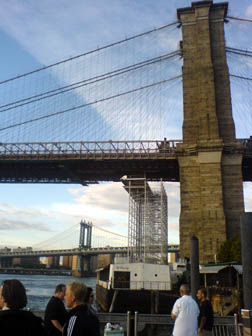
MOMA and PS1 prepare the public for the “Watersfalls” later this month in NYC. The the scaffolding has been constructed under the Brooklyn bridge. Photo taken on May 26.
From the Bay Area and Boston emerge artworks that are mainly science projects overlaid with pretty colors so they can be called “art”. The interaction is fun for ten minutes and we like to take new visitors as they will marvel. We fake enthusiasm based on a memory our our first time so that we can truly enjoy their reaction. But the work fails to provide any personal thrill again. And for all the statements by the artists and curators, no significant thought comes to mind at all – except the terror of the possible future.
Olafur Eliasson moves between public science project and public art. Many are science tricks directed toward internal artworld reflections. A moving colorfield painting in light, the live black&white 3-D movie or the invisible white gallery box inside the white gallery box. Some are little silly like the reverse cascading waterfall where he sprays the water up from one pool to the next.
The genius of Eliasson emits from his stubborn battle with the photographic record: still or moving. He seeks to make works that can only be completely appreciated through “being-in” the artwork. (I have written about “being-in” regarding the architecture in the northwest USA – a place grounded in Scandinavian culture like Eliasson). Yet, many of Eliasson’s best installations “The Weather Project” at the Tate Modern in London and the 360 Degree Room of All Colours at MOMA generate “artistic” amateur photos in the same way as Gromley’s work. His is a battle, not a rejection.
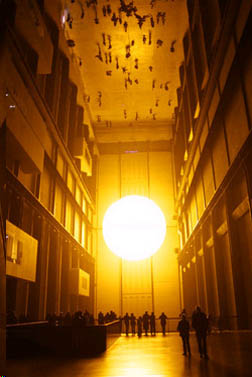
Anything claiming to be art requires the in-person experience to be fully appreciated. If you see a documentary picture or video of an artwork and think the artwork will be the same in person, then in my book you have a problem. (Of course the LCD monitor or paper magazine can be the intended home of the art.) The amateur photographs of The Weather Project make me want to be there. Through the photos, I have a sense, true or not, that the experience would be romantic and enveloping. Gromley’s work makes me want to compete in the undeclared photo taking contest, not necessarily to be in the space. Eliasson’s photos make me dream of the visit.
Two of the works at MOMA are brilliant and the “Take Your Time” room at PS1 exceeds any carnival fun-house of mirror rooms and tricks. Completely ignored by nearly all visitors, beige moss – of a type used for architectural models – densely covers each inch of the large gallery wall. Moss Wall is a visual trip over the Amazon Rain forest. Only by viewing the work from 6-10 inches can it unfold. As that visual range, the human eye and brain together imagine “depth of field” and a complete 3D visual experience that become physical. The human brain feels the tiny changes in elevation as you move your head and eyes like an airplane plane. But at 200 or 300 feet above a real forest, the eyes and brain do not feel any 3D effect. Eliasson discovered that multidimensional physical reactions can be sparked in the body.
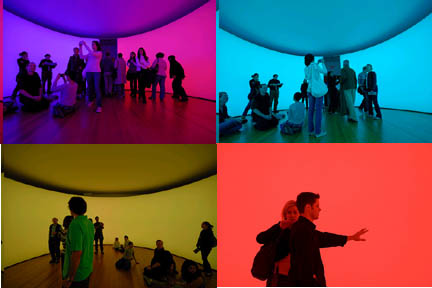
360 Degree Room of All Colours turns color into music. The circular space changes its pastel colors in slow repetition. The light level is PERFECT for the human eye in that pupil is fully open without the need to squint. If you stare into the fabric walls from 10 inches, your entire field of vision fills with one color. Only on a sail-less boat in the sea with a low sun, can you stare at the dome of the sky with a similar full view of blue. I loved it, but this is not the surprising part. If you sit of floor and a stare, the color change from washed out to very intensive pastel. My body started to feel the motion of the colors in ways that can only be compared to music. The chemical levels in my body shot up with the swelling of the color intensity.
Since architecture school, I had been told of psychological power of color, but never the physiological. Still part science, but like other chemicals in the body, I am hooked and looking for my next dose.
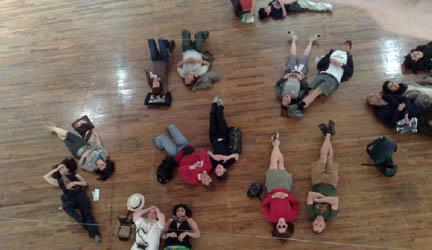
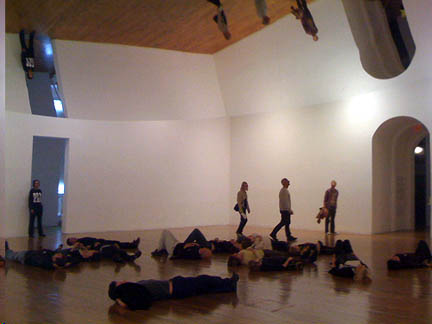
Finally, Take Your Time at PS1. A huge disc cover red in reflective mylar rotates very slow on the ceiling. Immediately, everyone dives to floor and looks up. Your brain tells you that all the people – including yourself – are not lying on the floor, but suspended magically on a vertical wall with less effort that Spiderman. That is the fun house trick. The questions is – why do you want to lay there for minutes and minutes? People don’t want to leave.
The mirror is tilted about 3%. Patience and 3% is the genius of the work. The angle causes the reflection of the visitors and the walls of the room to change very, very slightly in a loop. Again, somehow and for some reason, the brain knows that the view is changing and therefore remains alerts and interested. Unless you move the very edge of the disk, you can get yourself to consciously recognise the change. Like the colors in the 360 Degree Room, you body responds – in this case the brain – without consciousness.
Perhaps Eliasson has invented the first of science of art since gestalt.
I don’t know how other creative people can utilize Eliasson’s operational observations, but the work drives home the memory of special sunsets and hours napping adjacent to a waterfall in the forest. He proves that humans can make the spaces that facilitate these calm and happy moments. Thank you Mr. Eliasson.
Thank you for the Images
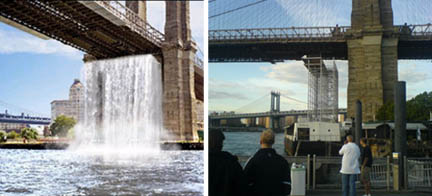
The Waterfalls produced by the Public Art Fund. Opening soon.

FW writes:
Your introduction had me believing you would actually include the work of Eliasson in the one-trick science as art combo.
But I see you wish to elevate him. Oh well. Perhaps the emptiness of his work is not unlike that earlier, fast-food popularity of Escher or as you note, gestalt diagrams.
It is conservative. The removal of anything experimental in the psychedelic, the renunciation of any “unnecessary” marginal information (like culture etc) to obtain the behavorialist lab-like set-up for testing the “human” experience. These are just appealing as bad chill-out lounges, as if “tests” and “art” which has nothing to do with the possibilities of art but belongs to simplifying framing certain visual, or perceptual-based issues.
If you are aware of any science-based discourse belonging to chemistry, physics or so on, this looks like that which belongs in the kids science museum.
Which IS apparently what Eliasson brings – a perfect match to what the new art museums and such want. Simplistic, non-controversial “science” tricks, as they still refuse to figure out what they are and go for more and more attendance figures as their answer.
Museums require formalistic work to draw in the oohs and aahs of crowds, of the mass public, and so everyone is happy.
But there is nothing else going on in these that hasn’t been done WITHIN other more complex works, including in theater, cinema and architecture, as well as sciences, that also ask for a bit more of art than going back to “how I feel man”.
Eliasson’s work is packaging one kind of experience and that fits perfectly to the dumbed-down museum world. Without any bad hang-over of “culture” and the like.
A perfect example of the god-scientist avoiding actual culture and reality: the musical instrument he is trying to “create” with some other geeks, is to claim a new “sound” and so on. And of course it looks like a classical instrument to some degree. “HIGH ART”. But only by ignoring the history of culture in the 70s and 80s especially would one still think in these isolationalist ways (perfect for art museums). The new instrumentation came from the street up, and it has since the 70s, but it was democratic and hybrid. Eliasson wants a return to the purity of science, a conservative class who once again bridges science and art without actual culture involved.
And we get ooohas and aaaahs and lots of well-financed museum gigs where lights change and mirrors and…the creation of a “new classical instrument” for an era that has shown none of this is desired and is certainly not art, but kitsch design for the elite and museums and for channeling the larger mass audience through.
Enjoy staring into space…
Weiss responds:
I agree.
My comments recorded my physical responses to the work. If I recall correctly from Thomas Kuhn and his writing on scientific revolutions, many, many small technical advances by many, many scientists are required for a revolutionary break-through. Eliasson’s work is one of those tiny steps. Someone else will take advantage of the steps and make more complex works.
As to the general passion for the prominance of artworks as critical dialogue, we wait and hope. We needed WWI and the Vietnam War for the last two waves. I pray the wave starts from something than war in the next version.